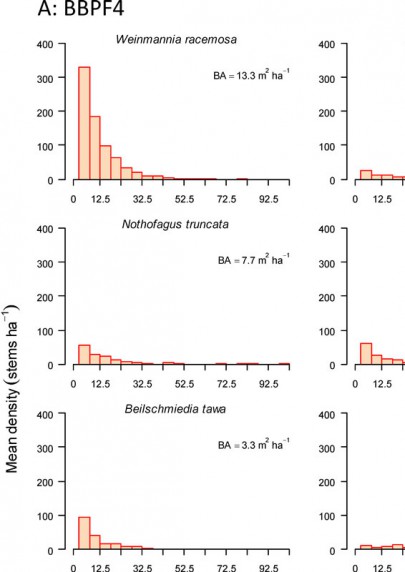Weinmannia racemosa - Cyathea dealbata - Knightia excelsa (Beilschmiedia tawa) / Leucopogon fasciculatus forest
In this section
Common name: Kāmahi - silver fern forest
Code: A: BBPF4
Where does it occur?
This alliance occupies 348 000 ha, primarily on the North Island south of 37°, and a few northern South Island locations. It occurs from sea level to 760 m.
Description
The forest is dominated by Weinmannia racemosa, Cyathea dealbata, Leucopogon fasciculatus and Knightia excelsa. No species are diagnostic. Beilschmiedia tawa, Dacrydium cupressinum, Prumnopitys ferruginea, Elaeocarpus dentatus, Pseudopanax crassifolius, Nothofagus solandri and N. truncata may be emergent or occur in the canopy and subcanopy. Important species in the subcanopy are Hedycarya arborea, Geniostoma rupestre, Olearia rani and occasional Freycinetia baueriana, marbleleaf and mahoe.

A: BBPF4. Size structure of canopy dominants.
Important species in the ground layer are Hymenophyllum demissum, H. sanguinolentum, Blechnum discolor, Microlaena avenacea and Astelia solandri. Species richness is moderate with on average 54 species per plot, with half of these (27) being measurable trees. Ferns are important in this forest class, comprising on average 30% (16) of the species. Exotic species richness is low to moderate (mean = 1.5 per plot, range 0–7) but no individual species is particularly frequent. This class is especially important in the provision of fleshy fruits for birds.
Indicator species
Co-occurrence of Knightia excelsa, Nothofagus solandri, Trichomanes reniforme OR
Cyathea dealbata, Knightia excelsa, Leucopogon fasciculatus and Nothofagus solandri.
Stand characteristics
| Mean canopy height (m): | 19 m (range 8–28) |
| Mean stem density (stems/ha): | 3214 (301) |
| Mean basal area (m2/ha): | 59 (3.9) |
Synonyms
| Relationship | Name | Author |
|---|---|---|
| includes | Tawa, kamahi, rimu, northern rata and black beech forest | Singers & Rogers (unpublished) |
| includes | Tawa, rimu, northern rata and beech forest | Singers & Rogers (unpublished) |
| overlaps with | Conifer/broadleaved forests of lower altitudes: Taranaki to the Marlborough Sounds | Wardle (1991) |
| overlaps with | Beech forests: other beech stands of the North Island | Wardle (1991) |
Component Associations
Weinmannia racemosa - Nothofagus solandri - Cyathea dealbata - Knightia excelsa / Leucopogon fasciculatus forest
Common name: Kāmahi – black/mountainbeech – rewarewa – silver fern forest
Code: a: BF22
Where does it occur?
This 53 000 ha association has been sampled primarily from Taranaki but also occurs in the Tararuas and Eastern Wairarapa. Sites range from flat to very steeply sloping (55º). Altitudes range from 140 to 606 m.
Description
This forest association is, on average, 18 m tall but can range from 7 to 28 m. It tends to contain a moderate amount of species with an average of 32 species on a plot which can reach 66. On average, there are few (less than 2%) exotic species present.
References
Wiser, S.K., Hurst, J.M. 2010. Composition and structure of 24 New Zealand forest and shrubland vegetation communities. Landcare Research Contract Report LC0910-073. Prepared for the Department of Conservation and the Sustainable Management Fund of the Ministry of Agriculture and Forestry.
Wiser, S.K., J.M. Hurst, R.B. Allen, E.F. Wright. 2011. New Zealand’s forest and shrubland communities: a classification based on a nationally representative plot network. Applied Vegetation Science 14: 506-523.
Wiser, S.K.; De Cáceres, M. 2013. Updating vegetation classifications: an example with New Zealand's woody vegetation. Journal of Vegetation Science 24: 80-93.
De Cáceres M, Legendre P, Wiser SK, Brotons L (2012) Using species combinations in indicator value analyses. Methods in Ecology and Evolution 3(6): 973-982.


